B-cell Receptor Silencing Reveals the Origin and Dependencies of High-Grade B-cell Lymphomas with MYC and BCL2 Rearrangements
- PMID: 40402557
- PMCID: PMC12209767
- DOI: 10.1158/2643-3230.BCD-25-0099
B-cell Receptor Silencing Reveals the Origin and Dependencies of High-Grade B-cell Lymphomas with MYC and BCL2 Rearrangements
Abstract
The B-cell receptor (BCR) is critical for mature B-cell lymphomas (BCL), serving as a therapeutic target. We show that high-grade BCLs with MYC and BCL2 rearrangements [HGBCL-double-hit (DH)-BCL2] predominantly exhibit immunoglobulin heavy (IGH) chain silencing, leading to BCR shutdown. IGH-silenced HGBCL-DH-BCL2 (IGHUND) tumors differ from IGH+ counterparts in germinal center (GC) zone programs, MYC expression, and immune infiltrate. Whereas IGH+ HGBCL-DH-BCL2 tumors favor IGM/IG-κ expression, IGHUND counterparts complete IGH isotype switching and IG-λ rearrangements. IGHUND lymphomas retain productive IGHV rearrangements and require IGH for optimal fitness. BCR silencing, caused by accelerated IGH turnover and reduced IGH expression, precedes HGBCL-DH-BCL2 onset, inducing RAG1/2-dependent IG light chain editing and facilitating t(8;22)/IGL::MYC translocations. IGHUND HGBCL-DH-BCL2 models exhibit reduced sensitivity to the CD79B-targeting antibody-drug conjugate polatuzumab vedotin. Collectively, HGBCL-DH-BCL2 commonly arises from isotype-switched t(14;18)+ GC B cells, which edit IG light chains, fueling intraclonal diversification, BCR extinction, and t(8;22) while maintaining IGH dependence, with clinical implications.
Significance: These findings link BCR silencing in IGH isotype-switched t(14;18)+ GC B cells to RAG1/2 expression, which triggers IG light chain editing and predisposes to IGL::MYC translocations, promoting HGBCL. In HGBCL with MYC and BCL2 rearrangements, BCR silencing protects from polatuzumab vedotin killing. See related commentary by Shevchenko and Hodson, p. 284.
©2025 The Authors; Published by the American Association for Cancer Research.
Conflict of interest statement
R. Siebert reports grants from the German Ministry of Science and Education (BMBF) during the conduct of the study and other support from AstraZeneca and Rhythm outside the submitted work. G. Pruneri reports grants from Novartis and personal fees from Lilly, Illumina, and Thermo Fisher Scientific outside the submitted work. S. Hohaus reports personal fees from Roche, BeiGene, Takeda, Incyte, Gilead, NovartisLilly, Abbvie, Bristol Myers Squibb outside the submitted work. No disclosures were reported by the other authors.
Figures
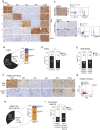
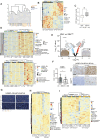
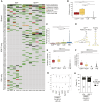
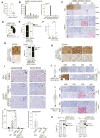


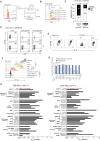
References
-
- Casola S, Perucho L, Tripodo C, Sindaco P, Ponzoni M, Facchetti F. The B-cell receptor in control of tumor B-cell fitness: biology and clinical relevance. Immunol Rev 2019;288:198–213. - PubMed
-
- Varano G, Raffel S, Sormani M, Zanardi F, Lonardi S, Zasada C, et al. The B-cell receptor controls fitness of MYC-driven lymphoma cells via GSK3β inhibition. Nature 2017;546:302–6. - PubMed
MeSH terms
Substances
Grants and funding
- CoronAId/Fondazione Cariplo (Cariplo Foundation)
- CoronAId Iperimmuni/Fondazione Spedali Civili di Brescia
- 2013432/US-Israel Binational Science Foundation
- PNRR-MAD-2022-12376707/Ministry of University and Research
- Project SCALE UP (Department of Excellence 2023-2027)/Italian Ministry of University and Research to the Department Molecular Biotechnology and Translational Medicine, University of Milan
- Project CN00000041 - "/Italian Ministry of University and Research, Investment 1.4 [CN3] SPOKE 2, lotto 5 of the National Recovery and Resilience Plan (PNRR) funded by the EU "Next Generation EU" [CUP B63C2200061.
- National Center for Gene Therapy and Drugs based on RNA Technology"/Italian Ministry of University and Research, Investment 1.4 [CN3] SPOKE 2, lotto 5 of the National Recovery and Resilience Plan (PNRR) funded by the EU "Next Generation EU" [CUP B63C2200061.
- Post-doctoral fellowship/Fondazione AIRC per la ricerca sul cancro ETS (AIRC)
- Fellowship/Fondazione Beretta (Beretta Foundation)
- Global Research Award AGRA2023-4/American Society of Hematology (ASH)
- H2020-MSCA-IF-2019 #895887/H2020 Marie Skłodowska-Curie Actions (MSCA)
- H2022-MSCA-IF-2022-PF-01 # 101111183/H2020 Marie Skłodowska-Curie Actions (MSCA)
- Progetto Giovani Ricercatori/Fondazione Cariplo (Cariplo Foundation)
- H2020-MSCA-ITN - 765158-COSMIC/Marie Sklodowska-Curie Innovative Training Network
- Fellowship/Bar-Ilan University President's scholarship
- IG #23747/Fondazione AIRC per la ricerca sul cancro ETS (AIRC)
- IG #22145/Fondazione AIRC per la ricerca sul cancro ETS (AIRC)
- PRIN #2017ZXT5WR/Italian Ministry of University and Research
- PRIN #2017K7FSYB/Italian Ministry of University and Research
LinkOut - more resources
Full Text Sources
Research Materials
Miscellaneous

